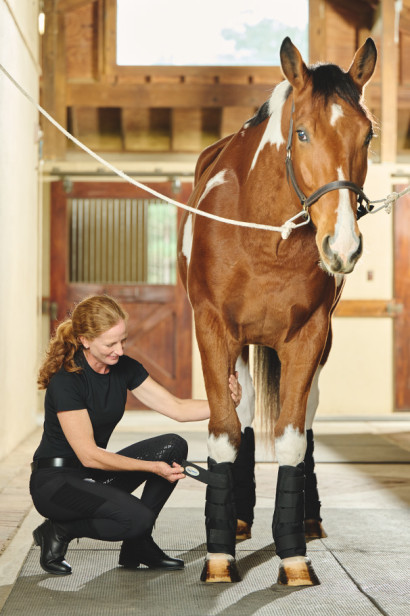Why Equine Therapy is Becoming a Preferred Alternative for Emotional Wellness
Why Equine Therapy is Becoming a Preferred Alternative for Emotional Wellness
Blog Article
Assessing the Performance of Laser Therapy in Equine Therapy for Injury Recovery
The assessment of laser therapy's efficiency in equine injury rehab pivots on several aspects, including recovery time, pain mitigation, and tissue regrowth. Vets often observe remarkable end results with laser treatment contrasted to traditional approaches, placing it as a crucial aspect in equine care.
Comprehending Laser Therapy
Laser therapy has become a crucial device in veterinary medication, specifically in the therapy of equine problems. Recognized for its non-invasive nature and efficiency, laser therapy includes the application of particular wavelengths of light to promote cells repair work and reduce inflammation. This restorative method is significantly favored for its ability to speed up the healing procedure in equines suffering from a variety of bone and joint injuries and persistent problems.
The primary system behind laser therapy is its ability to improve mobile functions. Additionally, laser therapy promotes vasodilation, enhancing blood circulation and oxygen shipment to broken tissues, therefore expediting recovery.
In equine medicine, laser treatment is particularly advantageous for conditions such as tendonitis, osteoarthritis, and wound recovery. The technique is admired for its pain-relieving properties, allowing steeds to regain wheelchair and function a lot more quickly. Vets additionally appreciate its marginal side impacts compared to other treatment techniques, making it a trusted and risk-free choice for equine care.

How Laser Treatment Functions

Upon absorption, these photons activate a collection of biochemical adjustments, improving mitochondrial function and resulting in enhanced adenosine triphosphate (ATP) production. This increase in ATP accelerates mobile metabolism, advertising tissue repair and regrowth. In addition, laser treatment modulates inflammatory responses by affecting cytokine levels and decreasing oxidative stress, thus reducing pain and swelling.
Another significant aspect of laser treatment is its duty in improving microcirculation. The treatment advertises vasodilation, enhancing blood flow and oxygen shipment to damaged tissues (Equine Therapy). This promotes the elimination of cellular particles and supports the spreading of fibroblasts and collagen synthesis, crucial for wound healing
Medical Proof
The efficiency of laser therapy in equine treatment has actually been validated via numerous professional research studies, showcasing its restorative possible throughout a variety of problems. A study carried out by Turner et al. (2012) demonstrated that horses treated with low-level laser therapy (LLLT) for tendon injuries displayed increased recovery contrasted to those receiving traditional treatments.
In a similar way, research by Johnson and coworkers (2015) concentrated on equine muscle mass injuries, revealing that laser treatment dramatically quickened muscular tissue fiber regrowth and minimized muscle mass rigidity. Clinical analyses have actually revealed that laser therapy can minimize chronic problems such as osteo arthritis.
Veterinarian Insights

Vets look at this site additionally appreciate the versatility of laser therapy. It can be utilized for a wide variety of conditions, from shallow injuries to deeper bone and joint injuries. Dr. Emily Brown highlights its utility in dealing with problems like tendonitis and osteoarthritis, where traditional treatments commonly fall short. She explains that laser treatment can be tailored to the certain demands of each horse, guaranteeing optimum outcomes.
Additionally, veterinarians value the ability to integrate laser therapy with various other therapy techniques. This multimodal technique can enhance general therapy efficacy, supplying a thorough option for equine rehabilitation. Such recommendations from skilled specialists highlight the growing approval and application of laser treatment in equine medicine.
Practical Factors To Consider
An essential element of applying laser treatment in equine treatment entails comprehending the practical factors to consider that guarantee its efficacy and safety. It is vital to choose the suitable laser device, as different types vary in wavelength, power, and infiltration depth. go to my blog Veterinarians need to be skilled in these parameters to customize treatment procedures efficiently to each injury type
In addition, the regularity and duration of laser therapy sessions require mindful preparation to maximize therapeutic benefits while decreasing any type of potential damaging effects. Constant monitoring of the horse's response to therapy can lead necessary modifications in the therapy regimen. Developing a secure and controlled environment throughout treatments is likewise important to stop unexpected exposure to laser exhausts, which could harm both the equine and the handler.
Educating and certification of personnel administering laser therapy are critical to make sure correct strategy and to maintain security requirements. Furthermore, preserving precise records of each session, including laser settings and observed results, is vital for evaluating the total performance of the therapy and for making data-driven decisions.
Verdict
Laser therapy has emerged as an efficient method in equine injury rehabilitation, using significant benefits in recuperation time, pain alleviation, and cells healing. Scientific researches emphasize substantial enhancements in problems such as tendonitis and osteo arthritis, credited to enhanced mobile feature and boosted ATP manufacturing. Veterinarian observations affirm these findings, highlighting remarkable outcomes compared to standard treatments. For optimal results, continual monitoring and personalized therapy procedures continue to be necessary in leveraging the full capacity of laser treatment in equine visite site care.
Report this page